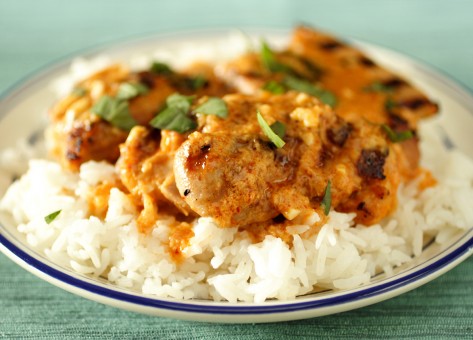Evil Jungle Grilled Chicken with Red Curry, and the Recipe Telephone Game
 Earlier this month, over Labor Day weekend, I took a rewarding and inspiring writing workshop lead by Crescent Dragonwagon, a warm and nuanced, broadly talented, and gifted writer who has been thinking about, writing about, and teaching about the process of writing for a lifetime.
Earlier this month, over Labor Day weekend, I took a rewarding and inspiring writing workshop lead by Crescent Dragonwagon, a warm and nuanced, broadly talented, and gifted writer who has been thinking about, writing about, and teaching about the process of writing for a lifetime.
The workshop, called “Fearless Writing,” takes a holistic view: There is the thing of writing—involving objective realities such as craft, process, and habit—and there is the life of the writer, or simply life, often unpredictable, unruly, but rich, with which the act of writing intercepts and is inseparable.

Spring-fed pond on Crescent Dragonwagon's property, one of two available to Fearless Writing participants
During one of the memorable exercises, a more complex version of the childhood telephone game, participants paired off and, while strolling about, told each other one-sentence story lead-ins: “I could tell you about the time when . . . .” Eventually each of us asked our partner to tell us the story that had most piqued our interest. We then swapped partners a couple of times, with the instruction of retelling our last partner’s story to the new partner, but with one change—be it an omission or addition. Later that same evening, after the filtering haze of time had done its work, we each retold the last story we had heard to the group, with one more change. The changes were dramatic—sometimes the stories took on levity, sometimes absurdity, or sometimes a gravitas—yet all retained the kernel of the original story.
I can’t help but think of this recipe for Evil Jungle Chicken in the same way, which has been retold a couple of times by now. Of the many intriguing recipes in Jay Solomon’s book Global Grilling, I was seduced by Evil Jungle Chicken’s provocative, “I-dare-you-to-make-me” name, and by its ingredients list, which, with one look, tells you that it will be delicious. All of the key aromatics and sweet-sour-spicy-salty building blocks that give Thai food its appealing taste, and make it so popular, are there: coconut milk, ginger, lemongrass, chili-laden red curry paste, lime juice, the all-essential fish sauce, fresh Thai basil.
The inspiration for Solomon’s version comes from a similarly named Thai curry dish. He took the flavors of that dish and adapted them for the grill, converting a coconut-based curry to a marinade. He recommends serving the grilled chicken with Thai Peanut Sauce, also in Global Grilling, and Jasmine rice. Feeling too lazy to make an additional recipe, I decided to incorporate the flavor of peanuts directly into the marinade, and rather than discard all of those wonderful Thai flavors bound up in the marinade, I simmered it while the chicken was grilling, for use as a sauce. I then tweaked the marinade-cum-curry sauce a bit further, adding a touch of light brown sugar (a common replacement for the harder-to-find, but more authentic, palm sugar) and additional curry paste to increase the heat. Oh, and I nearly doubled the ratio of marinade to chicken because the resultant curry sauce is so good—the more the better, I say. (You will want enough to coat each grain of rice.) My roundabout adaptation, with its emphasis on the curry, returns the dish closer to its original form, but retains the flavor of the grill ingenuously introduced by Mr. Solomon.
Adapted from recipe in Global Grilling by Jay Solomon
Serves 4 to 6
Marinade
2 tablespoons vegetable oil
8 cloves garlic, minced
3 tablespoons minced or finely grated fresh ginger
3 tablespoons minced lemongrass (see Notes)
5 tablespoons red curry paste, or to taste (see Notes)
2 (13.66-ounce) cans coconut milk (scant 4 cups)
¼ cup fish sauce
¼ cup fresh lime juice
2 tablespoons coarsely ground roasted, unsalted peanuts
1 tablespoon light brown sugar
½ cup (packed) fresh Thai basil leaves
****************************************
2 pounds boneless, skinless chicken thighs, trimmed of excess fat and cut into 1½- to 2-inch-wide pieces (see Notes)
Torn fresh Thai basil leaves for garnish
- Heat the oil in a skillet over medium heat and add the garlic, ginger, and lemongrass. Cook for 2 or 3 minutes, stirring frequently, to soften. Add the curry paste and cook for 1 or 2 minutes more, stirring often.
- Stir in the coconut milk, fish sauce, lime juice, and peanuts and bring to a simmer. Stir in the ½ cup basil leaves and remove from the heat.
- Let cool to room temperature (or chill in a bowl set over ice, for faster results).
- Add the chicken to the marinade, turning the chicken pieces until well coated. Marinate in the refrigerator overnight or up to 24 hours, turning the chicken from time to time.
- Preheat the grill until the coals are gray or white or, if using a gas grill, to medium-high heat.
- About 20 minutes before you’re ready to grill, remove the chicken from the marinade to allow it come to room temperature. (Do not discard the marinade.)
- In a saucepan, bring the marinade to a simmer over gentle heat. Let simmer for a few minutes and then reduce the heat to the lowest setting or move the pan to the back of the stove to keep warm. (If the oil from the peanuts separates, simply stir back into the sauce.)
- When the grill is hot, oil the grates. Place the chicken on the hot grill and cook, covered, for 5 to 7 minutes per side, depending on size, until the chicken is cooked but still juicy at the center. If the chicken pieces begin to brown too quickly, move to a cooler area of the grill.
- Serve the chicken with jasmine rice, an abundant amount of red curry sauce (I recommend much more than what’s shown in the photo!), and a sprinkling of torn Thail basil leaves. Alternatively, for a full-immersion experience, cut the grilled chicken into bite-size pieces and place directly in the heated marinade, then spoon the curry sauce and chicken over rice.
Notes: To prepare lemongrass, trim the root end of the stalk, cut off the top third or so (the green, woody part) and discard, leaving 4 to 6 inches at the bottom, and remove the tough outer sheaths of the stalk and discard. Cut the stalk crosswise into thin rings, then mince.
Prepared red curry paste is available bottled or canned at Asian markets catering to a Southeast Asian clientele and at most grocery stores, food co-ops, and specialty stores. Each brand will taste slightly different, and vary a bit in the amount of chili heat. I tried two brands—those that were available at my local food co-ops: Thai Kitchen and Maesri. Thai Kitchen’s red curry paste was hotter than Maesri’s, but the flavor of the Maesri paste was more delicate and refined. I used equal parts of both, to get the best of both: more chili heat and nuanced flavor.
Five tablespoons of curry paste creates a naughty (and nice) rather than truly evil amount of chili heat. If you like very spicy foods, 6 or 7 tablespoons of curry paste may be the right amount for you. If you don’t like much chili heat at all, start with 3 tablespoons. Taste as you go and add more if needed.

If I catch you cooking chicken again, Ginger, Della, Kate, Anita and I are going on strike. So just watch it!
Bob
1Er. Hello Bob.
Well, I don’t know if I can promise to never cook chicken again. But I promise not to make coq au vin out of you, or to eat the girls when their egg laying production slows. I don’t want you all organizing, like in that movie Chicken Run.
HJ
2